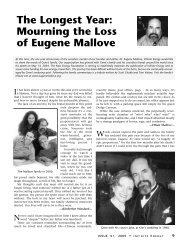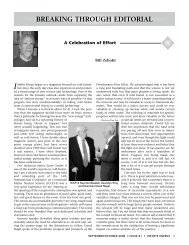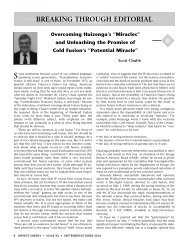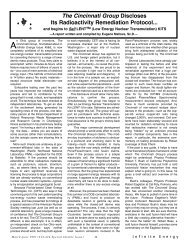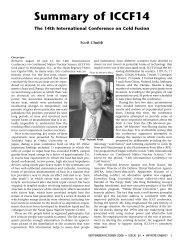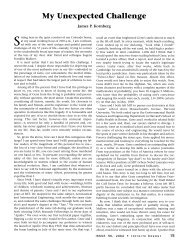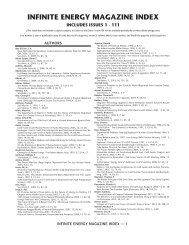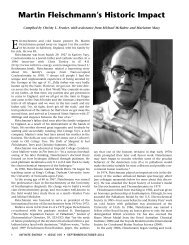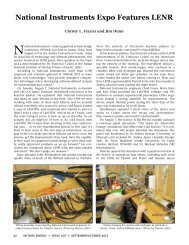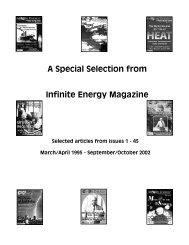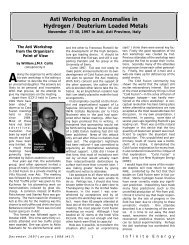MIT and Cold Fusion: A Special Report - Infinite Energy Magazine
MIT and Cold Fusion: A Special Report - Infinite Energy Magazine
MIT and Cold Fusion: A Special Report - Infinite Energy Magazine
Create successful ePaper yourself
Turn your PDF publications into a flip-book with our unique Google optimized e-Paper software.
not deemed important. After all, hadn’t he just “proved” that<br />
cold fusion was dead?<br />
PFC Director Parker then stated that this was the first time he<br />
had seen the data I had flashed on the screen—it probably was.<br />
Then Parker made the astounding assertion that “you can put<br />
those curves anywhere you wish.” He publicly stated that the<br />
data from the <strong>MIT</strong> PFC was “worthless.” (See Exhibit K). Many<br />
weeks later, after I had revealed the PFC story to the world, Parker<br />
reverted to defending the conclusions of the calorimetry data—<br />
in an informal press release put out by the <strong>MIT</strong> News Office (see<br />
Exhibit T). It must take many years of training to maintain such<br />
mutually contradictory opinions with a straight face—on national<br />
television <strong>and</strong> in written documents.<br />
Let me be clear: There was likely no gr<strong>and</strong> “conspiracy” to<br />
suppress a positive finding for excess heat in the <strong>MIT</strong> PFC-<br />
Phase-II calorimetry, it’s just that the mind-set of the <strong>MIT</strong> hot<br />
fusioneers <strong>and</strong> Chemistry Department people allowed lower<br />
echelon persons to monkey with the data. He or she could not<br />
possibly bring anything to his superiors—Ronald Parker <strong>and</strong><br />
then <strong>MIT</strong> Chemistry Dept. Head Mark Wrighton—that looked<br />
remotely positive for excess heat. This would have opened up<br />
the cold fusion story again in the summer of 1989, this time with<br />
<strong>MIT</strong> coming in with some encouraging news. So, the data was<br />
“fudged.” I can think of another F-word—beyond “fudging”—<br />
that applies. It is closer to the truth. Ronald Parker likes to<br />
b<strong>and</strong>y it about in interviews with newspaper reporters. This<br />
groundless, manipulated <strong>and</strong> fabricated data has subsequently<br />
been cited over <strong>and</strong> over again by the U.S. Patent Office to reject<br />
cold fusion patent applications. It was even used, in part, ultimately<br />
to kill the Pons <strong>and</strong> Fleischmann patent itself, which<br />
happened in the Fall of 1997. Other <strong>MIT</strong>-trained cold fusion<br />
inventors have also had their patent applications attacked with<br />
this unscientific travesty from <strong>MIT</strong>.<br />
Perhaps the most remarkable aspect of the <strong>MIT</strong> PFC experiment<br />
was that after I publicly challenged it, the objective of the<br />
experiment was redefined by its defenders! Thus, it is quite literally<br />
true that the experiment published in the Journal of <strong>Fusion</strong><br />
<strong>Energy</strong> <strong>and</strong> the <strong>MIT</strong> PFC technical report is by definition fraudulent—if<br />
only because the ground rules for comparing the heavy water<br />
<strong>and</strong> ordinary water experimental outputs were subsequently changed<br />
<strong>and</strong> are not as stated in the article. These ground rules went from<br />
the obvious implication that can be taken from the lack of difference<br />
between the published curves to the statement that the<br />
<strong>MIT</strong> PFC team were looking for “fast turn on” of 79 mW excess<br />
heat <strong>and</strong> didn’t find it! See NIH physicist Dr. Charles<br />
McCutchen’s letters to the <strong>MIT</strong> Administration about this key<br />
point—Exhibits Z-4, Z-8, <strong>and</strong> Z-11. Dr. Mitchell Swartz has produced<br />
a remarkable, clear analysis of the data produced by the<br />
<strong>MIT</strong> PFC—including all<br />
of the various inconsistent<br />
versions of the data<br />
<strong>and</strong> their interpretation).<br />
The work speaks for<br />
itself. Interested readers<br />
may request the original<br />
color-graphic paper<br />
which is included in a<br />
paperback book from<br />
JET Technology, P.O. Box<br />
81135, Wellesley Hills,<br />
MA 02481.<br />
• Swartz, Dr. Mitchell<br />
R., “Re-Examination of<br />
a Key <strong>Cold</strong> <strong>Fusion</strong><br />
Dr. Mitchell R. Swartz of JET Technology,<br />
Inc. lectured on cold fusion calorimetry,<br />
January 20, 1996 at Cambridge Marriott<br />
Hotel. Meeting sponsored by <strong>Infinite</strong><br />
<strong>Energy</strong> <strong>Magazine</strong>.<br />
Photo by E. Mallove<br />
Experiment: ‘Phase-II’ Calorimetry by the <strong>MIT</strong> Plasma<br />
<strong>Fusion</strong> Center,” <strong>Fusion</strong> Facts, August 1992, pp. 27-40.<br />
• Swartz, Dr. Mitchell R., “A Method to Improve Algorithms<br />
Used to Detect Steady State Excess Enthalpy,”Proceedings:<br />
Fourth International Conference on <strong>Cold</strong> <strong>Fusion</strong> (December 6-9,<br />
1993, Lahaina, Maui, Hawaii), <strong>and</strong> in Transactions of <strong>Fusion</strong><br />
Technology, Vol.26, December 1994, pp. 369-372.<br />
• Swartz, Dr. Mitchell R., “Some Lessons from Optical Examination<br />
of the PFC Phase-II Calorimetric Curves, Proceedings:<br />
Fourth International Conference on <strong>Cold</strong> <strong>Fusion</strong> (December 6-9,<br />
1993, Lahaina, Maui, Hawaii).<br />
The Sham <strong>MIT</strong> “Inquiry”<br />
I am very glad that Dr. Swartz undertook the task of this<br />
essential analysis, because certainly he was more capable than I<br />
in this kind of detailed examination of points that appeared <strong>and</strong><br />
disappeared in various versions put out by the PFC. He did it<br />
himself after I turned over to him the materials that I had discovered.<br />
I was so revolted by the h<strong>and</strong>ling of this matter by the<br />
<strong>MIT</strong> Administration, that I really could not st<strong>and</strong> to wallow in<br />
the falsehoods coming out of the <strong>MIT</strong> PFC. My feeling was:<br />
“Let them stew in their own self-created problems. The world<br />
will eventually underst<strong>and</strong> what they did.” It will.<br />
After my formal complaint to <strong>MIT</strong> President Charles Vest in<br />
August 1991 (see Exhibit R), in which I asked for an appropriate<br />
investigation of scientific misconduct in the data h<strong>and</strong>ling <strong>and</strong><br />
in the planting of a false press story by Parker in 1989, the<br />
whole matter was, in effect, swept under the rug by Vest after<br />
an utterly insufficient examination of the technical issue by Professor<br />
Professor Philip Morrison, who was a friend of <strong>MIT</strong> PFC<br />
report co-author, Dr. Petrasso.<br />
Morrison’s down-playing of the issues involved was a great<br />
disappointment, but not surprising for someone who to this day<br />
does not comprehend the significance of the research results in the<br />
cold fusion field. A symptom of this: To my knowledge, Prof. Morrison—at<br />
least as of early 1999—has never reviewed in his wide<br />
ranging columns any cold fusion books—either positive or negative.<br />
In one of his notes to President Vest (Exhibit V), Morrison stated<br />
that cold fusion findings “would at most open some way to<br />
build a new battery, possibly a fuel cell.” This kind of ill-informed<br />
remark should be beneath the author of The Ring of Truth!<br />
Concerning the ethical issues of Parker’s dealings with the<br />
press <strong>and</strong> the <strong>MIT</strong> News Office, President Vest<br />
stated that his legal counsel advised him no action was necessary.<br />
It was a shameful, sham “inquiry,” not a thorough investigation,<br />
as the subsequent portion<br />
of this report <strong>and</strong> the various<br />
Exhibits show. I complained<br />
vigorously to<br />
President Vest that the<br />
inquiry was totally inadequate.<br />
In fact, the people<br />
who should should have<br />
been under investigation<br />
were allowed to continue<br />
<strong>MIT</strong> President Charles M. Vest,<br />
who continues to ignore cold<br />
fusion research. He excused the<br />
unethical behavior of <strong>MIT</strong> PFC<br />
staff against cold fusion. He is<br />
on a Federal panel that has<br />
advised the Clinton Administration<br />
to increase funding for hot<br />
fusion—a benefit for the <strong>MIT</strong><br />
PFC (see Exhibits R through Z-<br />
11).<br />
<strong>MIT</strong> Photo by Edward McCluney<br />
15 <strong>Infinite</strong> <strong>Energy</strong> • ISSUE 24, 1999 • <strong>MIT</strong> <strong>Special</strong> <strong>Report</strong>



